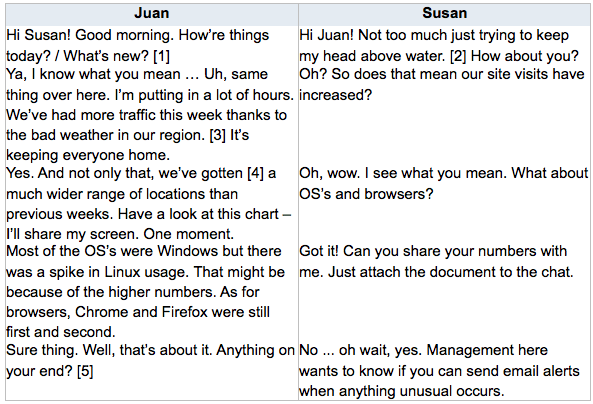In today’s blog, we’re going to introduce a new short series on how to make a practical lesson when you have little to no time to prepare one.
There are other things you can do with students instead of simply ‘free talking’ when you lack prep time. And we’re going to show you what you can do in our Lessons on the Fly series.
As some teachers reading this are aware, there are times when you aren’t able to prepare a full-length lesson.
Sometimes you have to sub a class. Other times you’re tasked to teach a new class that just popped up. Or, you walk into a classroom not knowing what you’re going to teach.
So today, we’re going to introduce a short series on creating lessons with limited preparation.
Our first one will be how to make a tailored dialogue just from small talk with your adult students.
In other words, by taking a little time to get to know your learners, you can better understand the contexts they might be used in English.
And if you understand the contexts better, you can prepare something practical for them.

How Dialogue Might Look
For example, if your adult private lesson student works as an IT analyst, you can ask him about his job.
You can find out in what contexts he uses English. Then, determine what they talk about (of course no company secrets).
Let’s say you discover through his introduction that Juan works as an IT analyst in an international software company and shares weekly updates with his colleague in the U.S. via video chat.
By way of conversation, you ask him what he specifically does. He tells you that he gathers data on client accesses on the software download site.
He gathers the IP addresses, geographic locations, the types of devices being used, the operating systems, and browsers used to do this.
Then you ask Juan the name of the person in the U.S. he often speaks to when reporting this information. He tells you her name is Susan.
Now you have pretty much the basics to create a dialogue. You can collaborate with him to fill in the rest (an exercise in itself). After, by way of dialogue, you can build more confidence in him using English in this context.
Get Professional Lesson Planning Training from OnTESOL!
Example Dialogue
Your dialogue might look something like this:

Analyzing the Dialogue
The reference numbers above are places where you can insert teaching points. Again, this helps create a well-rounded lesson for your learners – all on the go.
1. How to open a conversation.
Juan can learn how to open conversations. By simply beginning your dialogue with something you might naturally say, Juan can learn to do the same.
2. Expressions for being busy.
Teaching Juan expressions you might naturally use to indicate you’re busy can help teach him new vocabulary—on the fly.
3. How to transition.
Inserting a transitional statement such as this can teach Juan how to change topics. It shows him how he can use English to direct the conversation instead of the other way around—being led by the conversation.
4. Appropriate verb tense for the context.
Simply using English in a natural way, you are showing Juan proper use of verb tense. This is something that is natural for you, but not for him. By not overlooking the obvious, we can make the lesson more practical for Juan.
5. How to end a conversation.
Learners I meet are often unclear as to how to end a conversation. This natural manner of closing the dialogue can be a big help to Juan. Your learners would probably also appreciate this and all of our points above.
That’s because sometimes, they’re tired of learning book English—studying English. They often want to know how the language is naturally spoken. They want to understand and sound like what they hear on Netflix.
Of course, this is just an example. As you learn details from your students, you can make it more real. You’ll of course want to involve them in creating the dialogue to find out how you can make it more practical for them.
Some readers may be asking about group classes. Well, it works pretty much the same, but you’ll have to try and find willing participants and balance your approach.
Pick and choose the more practical roles for the group. If it doesn’t fit today, tell them you’ll try something new next time.
As mentioned in previous blogs, dialogues are a great way to teach real-world interactions. You can use them not only to teach what to say (i.e. structure and vocabulary), but also how to say it (i.e. pronunciation, intonation, word choices, expression, …).
That makes this lesson on the fly a practical application targeting learner needs. Furthermore, there will likely be more than one context where the student uses English.
That being the case, you’ve just created a series of potential lessons to work on with your learners.
Read: Planned Conversation Strategy to Develop ESL Learner Fluency
In the End
In the end, you’ve entered a classroom without a lesson but came in with your own Kung Fu. That means you may not have a lesson to teach but you can quickly adapt and overcome the situation.
Not only that, you’ve provided perhaps an even more practical lesson for your learners than they may have experienced before from other teachers who might play it by the book.
Stay tuned for the next installment of Lessons on the Fly.
What do you think? Share your experiences with this lesson about dialogue. Or, share your experience walking into a classroom unprepared. Was it a disaster or a triumph?
And remember, you can always contact us to learn more about teaching English as a Second Language. We offer internationally-accredited TESOL courses as well as supplementary courses for certified teachers.
Recommended Reading:
Lesson Planning 101: How to Develop Meaningful ESL Lessons





